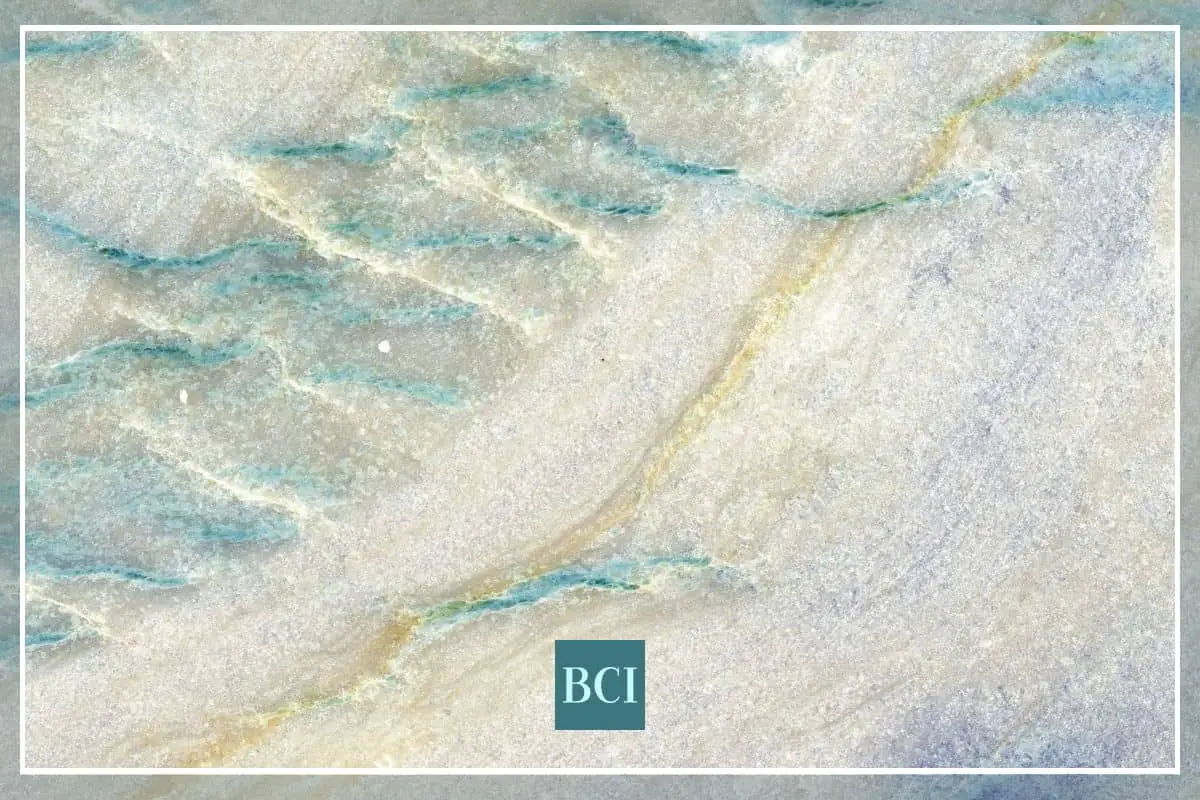Oh, those white kitchens. It seems like they’re everywhere! Are you lusting after a white kitchen with a lovely Calacatta marble countertop? But you know, deep down, that you’ll never be able to keep that white marble looking nice? Before you sigh and give up the dream, take a look at quartzite countertops.
Quartzite is a beautiful natural stone, that can look similar to marble, but has the durability and strength of granite. Its high-end look adds a level of luxury to kitchens and bathrooms. It can be the best of both worlds!

The Basics of Quartzite Countertops
Quartzite is a metamorphic rock that is a great choice for countertops. Originally, it was a quartz sandstone, and the metamorphic process has made it harder than granite. In fact, it’s even harder than glass.
But quartzite is more than just a hard and durable surface. It has become increasingly popular because of its natural beauty. Quartzite has a marvelous sense of movement across the slab. The veining is very pronounced, and usually in a parallel and linear direction, as opposed to the more random veining of marble. Slabs can also have swirls and striations that add to the interest. When looking at a quartzite slab, you can almost see how the various layers were formed and imagine the processes that transformed the stone.
Finally, quartzite has a wonderful color palette. Many slabs have similar colors to Carrara or Calacatta marble. Several stones are perfect for a white kitchen – White Princess, White Macaubas, and Snow Crystal, to name just a few. Taj Mahal is a lovely, cream colored choice, while Fantasy Brown leans more towards grey and beige. There are even options available in blue, green, or red.
Unfortunately, a marble slab can often be mislabeled as quartzite. In these cases, the stone material is softer, so it does not perform as expected. It can etch, scratch and stain. With that in mind, be sure to test and verify that the stone is actually quartzite.
Finally, while quartzite is non-porous, it should be sealed at least twice per year to avoid etching and staining.
Designing with Quartzite Countertops
Because quartzite is a natural stone, every slab will be slightly different – even from other slabs in the same bundle. With that in mind, you’ll want to visit the stone yard and pick out the individual slabs. Sequential slabs are best if more than one slab is needed, because they will have similar color and veining patterns.
Quartzite slabs are similar in size to granite slabs – about 5’x10’ – so most kitchens will need multiple slabs. The fabricator will suggest the number of seams, locations, and seam directions during the design stage. Be sure to pay close attention to color and veining at the seams so that the countertop looks like one continuous material. Keep in mind that it may not be possible to get a perfect alignment, so try to minimize the differences as best as possible.
Several surface finishes are available that can customize the look of quartzite. A polished surface will look glossy, and highlight the colors and veining of the stone. Honed surfaces will have a softer, matte appearance, and the veining and color will be more subdued. A leathered surface has a slightly rough surface with a soft sheen. It is great for hiding less-than-magazine-perfect housekeeping, and a great choice for families.
Like other countertop materials, there are numerous edge profile options for quartzite countertops. A simple eased edge can highlight the beauty of a slab, while the linear veining of quartzite is perfect for a waterfall edge.
Since quartzite countertops WILL be the star of a room, they can look amazing as the kitchen island countertop. It’s important to ensure that the other “players” (cabinets, backsplash, flooring) know their role as supporting characters. With that in mind, pick simple backsplashes. Avoid mosaics, penny rounds, and materials with a lot of action that will compete with the star. Let that baby be the star and let it shine!
Is Quartzite Cheaper than Granite?
It depends. When comparing similar grades of stone, quartzite will be a more expensive choice than granite. However, a more common quartzite can be cheaper than a granite that is more rare. It really all depends on the type of stone that is selected and it’s availability.
Our Free Countertop Costs Calculator can help determine which countertops will meet your budget.
Is Quartzite Good for Kitchen Countertops?
Quartzite is an excellent choice for use in the kitchen. While not as popular as granite kitchen countertops, it does provide the same strength and durability, but it has the beauty of marble. And unlike marble, it will not etch or scratch easily. Quartzite can be a stunning choice for an island countertop.
As I mentioned earlier, quartzite is perfect for a kitchen island where it can grab all the attention. A popular trend is an island with cabinets that are a different color than the perimeter. An island with blue cabinets and a beautiful quartzite top can be spectacular.
What is the Difference Between Quartz and Quartzite Countertops?
It’s easy to confuse these two, but they are quite different. Quartz is an engineered material, meaning it’s manmade. Manufacturers combine ground quartz with resins to create the slabs. Pigments and other natural materials are added to give a multitude of different color choices. Quartzite, on the other hand, is a completely natural stone that is quarried from the earth.
Quartzite really does have it all – beauty and durability. It is a stunning addition to today’s interiors.
Pin this for later:
